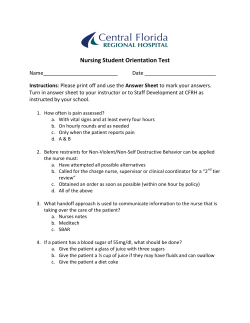
Juicers
Juicers The days of frantically twisting half an orange by hand on a plastic juicer and being happy with a thimble full of juice for all your efforts have thankfully long gone! More and more emphasis is being placed on getting your 5-a-day and healthy eating is big business. You can spend anything from £50 to £400+ on a juicer so it is important that you understand why there is such a price difference so you can make a considered purchase for your own specific needs. The Facts Centrifugal: for frequent use, least expensive Fruit and vegetables are fed down a tube whole, so no cutting or chopping is required as an internal spinning cutter travelling at a high RPM does that job for you by grinding and grating into tiny pieces. However, the wear and tear on the blades can mean that they need replacing more often. Centrifugal juicers do not cope well with leafy vegetables such as spinach, wheatgrass or herbs as this will clog the cutter so are best avoided The speed extracts the juice and pushes the pulp into an extractor. This is all done in seconds giving you fresh delicious juice but due to the air taken in during the process, this does reduce the storage time so juice needs to be consumed quite quickly. Less easy to clean due to the many cutting blades which can trap the pulp but less expensive than other categories of juicers. They can be quite noisy due to the cutting blades having to do extra work. Masticating “Slow” Juicers: mid priced, higher juice yield Ingredients can be fed in whole, no chopping required and can cope with leafy vegetables. Instead of a spinning cutter, these juicers contain a single gear blade that crunches the fruit and vegetables, breaking down tough fibres, giving more of the nutrients which can be consumed easily in a drink. Some masticating juicers (a little more expensive) have a design called “dual stage juicing”. This is where the juice is first of all extracted by crushing and then squeezed during the second stage. This gives a very high yield of juice, leaving the remaining pulp almost dry, showing that all the goodness is in the glass, not in the bin! They are not as fast as centrifugal juicers but the slower speed means less air and more vitamins and goodness is retained. They can be very heavy but give stability and durability for this type of juicing mechanism. They are easy to clean, especially if the model has a self cleaning feature where you pour water through to clear the juicer so it can be used again immediately for a different flavour of juice. Great for families with different tastes. Cold Press – for the serious juicers! These are the top line juicers of the Juicer World and are manufactured to the highest standards to withstand hard and frequent use. Just a flick of a button yields far more juice and more nutrients retained and gives only dry pulp. The pestle action can cope with all types of produce including fibrous vegetables such as celery, ginger, wheatgrass, herbs, apples and other fruit without having to peel them and produce a very high yield of juice and a drier pulp. However, the ingredients do need to be cut into smaller pieces due to the narrower feeding chute. They operate at a much lower speed than centrifugal or masticating juicers, which means that less air gets trapped into the juice, thus retaining more of the nutrients and your juice will last longer when stored in a fridge. The slower speed also means that the operation is very quiet. Higher quality cold press juicers use a single phase induction motors. This is widely regarded as one of the best available and in turn leads to consumer confidence with longer warranty periods. Due to the nature of the mechanism, these juicers can be used as a pasta maker, grinder or mincer. The easiest to clean – just run the part under a tap. For more information on a specific cold press juicer, see my Tried and Tested section and the Vitality4Life Bio Chef personal review.
© Copyright 2025










